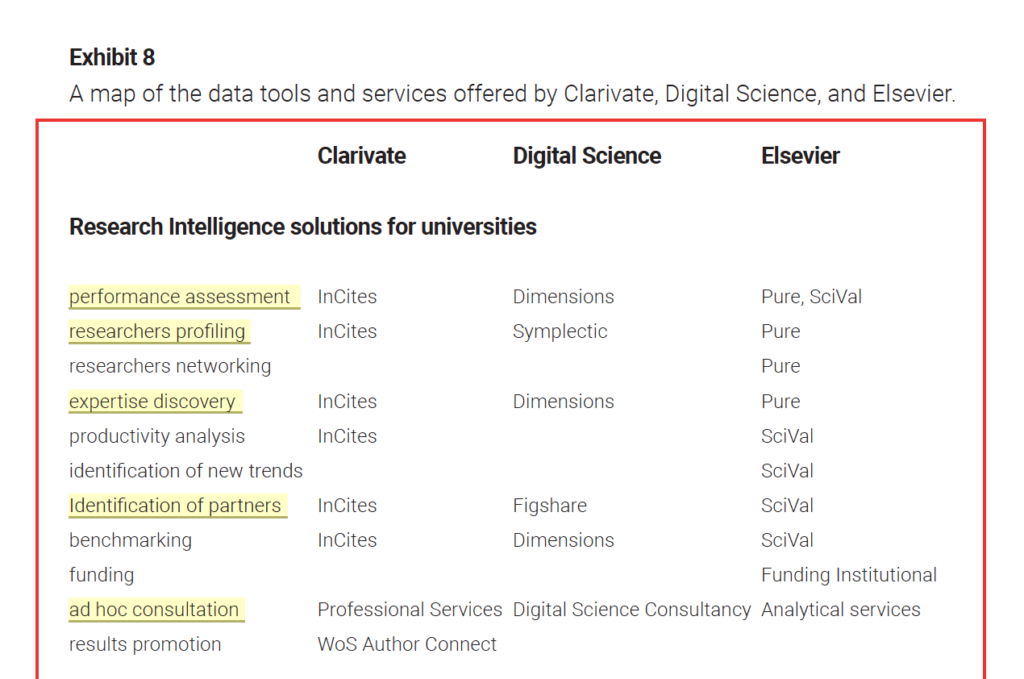Hi all,
I’m inclined to start things off by noting some of countervailing forces present in this week’s readings — one public-democratic, another private-capitalistic — each fighting for a foothold on the emergent knowledge infrastructures in the academy. In an attempt to frame our thinking on the topic, I abridged a series of associated themes, ethics, and practices from either set into a single-sentence bullet below:
- public-democratic: collaborative interventions aimed at facilitating more sustainable knowledge infrastructures among the academy and other social sectors, in turn channeling multivalent ways of knowing, DYI and hacker praxis, along with culturally situated acts of recovery and historical restoration.
- private-capitalistic: the neoliberal capitalization of higher education, by means of which free-market actors aggregate, analyze, and monetize academic knowledge production, effectively dispossessing scholarly and educational practices of their infrastructural sovereignty.
In what ways might we collaboratively leverage a DH-driven praxis to trouble or disrupt the data-driven exploitation of academic knowledge practices?
How might euro-centric academic knowledge production — specifically those aimed at archiving and representing indigenous data without consultation — fall into the equation? In what ways might Liu’s commentary on the hack/yack debacle inform your answer?
***
Moving forward, I feel it incumbent upon me to at least unpack some of the SPARC Landscape Analysis, if only because it is such a helpful document for working within the interventionist praxis of CI studies, not to mention critical university studies. Key to either project is the painstaking act of parsing infrastructural minutiae underlying individual company behavior, while further attending to how such nuances operationally play out across the wider neoliberal agenda of the academic publishing industry. For example, in the first half of Exhibit 8 below, the report chronicles “research intelligence solutions for universities” of Clarivate, Digital Science, and Elsevier, affording us a strong case for better understanding vested industry patterns — such as an inter-organizational view on which data-analytics services embody industry benchmarks.

I would at this point like to further reiterate some of the more pressing points of tension reported by SPARC in their analysis, such as their emphasis on accelerated rates of “commercial acquisition of critical infrastructure in [academic] institutions” (2). What’s more, notes SPARC, companies like Elsevier are well into the process of building and rolling out data analytics services intended to collect, parse, evaluate, and ultimately monetize data from the academic community, ranging from learner analytics and research output to productivity analysis and expertise discovery (31). Earmarking the same names over and over again — such as Cengage, Elsevier, and Pearson, whose 2018 annual revenues respectively totaled at $1.47, $2.54, $5.51 billion — SPARC urges higher-ed institutes to be wary of the educational services of these companies, which come with built-in data analytics that serve to profit from the capitalization of ongoing academic practices.
Which details or figures do you recall reading in the SPARC Landscape Analysis? Why did they stick out?
How might have the report been written differently to reach a wider audience, if at all?
Are there complementary ways in which we might synthesize these findings to reach not only the academic community, but also broader publics?
How might an awareness of such minutiae prepare us to challenge data analytics companies like Elsevier?
***
I apologize if this part of my blogpost comes off as at all rambling; much of it is my attempt to troubleshoot a few interesting but elusive comments from the prolegomena to “Sustainable Knowledge Infrastructures.” In it, Geoffrey C. Bowker compares a kitchen faucet to an accredited academic journal — which is funny, I agree, before turns out to be a tad complicated as far as the ontology/phenomenology of infrastructures are concerned. (More on that later.) More interesting, at least in retrospect, is his definition of infrastructure as not a what but a when — “The question is not so much “what is an infrastructure?” as “when is an infrastructure?” (204) — which is best understand via his claim that “to be infrastructural is to be in a subtending relationship with” (204). That is, according to Bowker, infrastructures come and go; they are contingent, nary but an indexical, named into being in terms of a complex network of interdependent utilities; or as Susan Leigh Star & Karen Ruhleder assert, “infrastructures are always relational: one person’s infrastructure is another ‘s site.”
Let’s go back to the kitchen faucet and the credentialed journal — could it be intended as a template to understand infrastructures across infrastructures, both of the physical and the knowledge variety? …
“It is clear that the taken-for-granted nature of turning on a tap and expecting water to come out of the faucet is equivalent to turning to an accredited journal and expecting knowledge to come out.”
Bowker (203)
Might Bowker’s “formal equivalence” in this case concern only the subject, the infrastructure (of the faucet), or perhaps even a synthesis of both?
How in particular does this formulation factor into the broader context of his argument for sustainable knowledge infrastructures? Why or why not?
For both the water/knowledge supply network, unseen backchannels surely abound. But I suspect the value in recognizing that — while we can always pipes can be seen knowledge infrastructures are consonant with physical is coming to terms with with phenomenological impression of either activity. As Susan Leigh Star & Karen Ruhleder write, “infrastructures are always relational: one person’s infrastructure is another ‘s site.”


